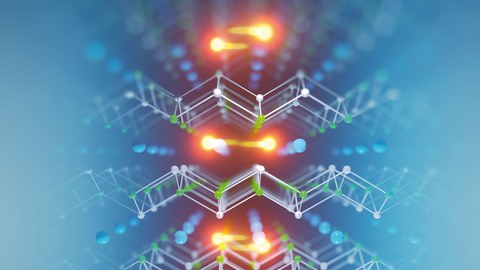Nov 04, 2022
New quantum professor in Dresden: With record low temperatures into the hotspot of solid state physics

Elena Hassinger has taken on the Chair of Low-Temperature Physics of Complex Electron Systems at the Würzburg-Dresden Cluster of Excellence ct.qmat – Complexity and Topology in Quantum Matter. The professorship has been newly established at TU Dresden.
Elena Hassinger has taken on the Chair of Low-Temperature Physics of Complex Electron Systems within the Cluster of Excellence ct.qmat – Complexity and Topology in Quantum Matter. The professorship has been newly established at TU Dresden. The researcher is an expert in solid state physics at very low temperatures down to 0.01 kelvin (-273.14 °C). She studies unusual quantum phenomena that only occur in the freezing cold, with the focus currently being on cerium rhodium arsenic (CeRh2As2) – a promising unconventional superconductor. As a Max Planck Fellow, Hassinger is strongly connected to the DRESDEN-concept network.
Unconventional superconductivity – key topic in quantum physics

The figure shows the exceptionally robust quantum material cerium-rhodium-arsenic (CeRh2As2), which Elena Hassinger is researching at the Cluster of Excellence ct.qmat. Cooper pairs (yellow) are located near the cerium atoms (blue). These are formed at very low temperatures from two electrons each and are a prerequisite for superconductivity. Collectively, they can form a quantum state and move through the superconductor without resistance.
Elena Hassinger’s experiments create surroundings that are colder than outer space. Last year, the expert in low-temperature physics and her colleagues succeeded in discovering the unconventional superconductor CeRh₂As₂, a quantum material which exhibits two superconducting states and was covered in the journal Science. Usually, only one superconducting phase occurs below a certain transition temperature where electrons are transported without any resistance. This lossless conduction of electricity in superconductors has been one of the key topics in solid state physics for decades and has become the great hope for energy technology. "In the meantime, unconventional superconductors have taken center stage because they are the best candidates for superconductivity at room temperature," Hassinger explains. "Through my work, I hope to better understand the mechanism responsible for superconductivity in these materials."
Potential for medical imaging
In CeRh₂As₂, the special superconductivity occurs below a very low transition temperature of 0.25 kelvin (-272.9 °C). Even upon applying a very strong magnetic field, this superconductivity is extraordinarily robust – which is novel. The material can withstand a magnetic field of up to 14 tesla before the lossless current transport disappears. By comparison, the magnetic field of a standard horseshoe magnet is 0.1 tesla. In the future, this property could lead to more accurate results in medical imaging. "In medicine, superconducting materials are currently used in magnetic resonance imaging scanners, for example. Our cerium-rhodium-arsenic compound can withstand a much stronger magnetic field in the superconducting phase than current superconductors. This could provide a much higher image resolution," elaborates Hassinger. The strength of a magnetic field used in today’s MRIs is usually that of three tesla; in medical research, up to seven tesla are applied. "In the beginning, basic research like the one I am carrying out primarily leads to new insights. But discovering new materials with unexpected properties has always culminated in technological progress over time."
Ice age in the lab: materials research under extreme conditions
To demonstrate its unique properties, the unconventional superconductor CeRh₂As₂ must therefore be cooled to temperatures below those that can be found in outer space, where temperatures around -270 °C prevail. "This can take up to 24 hours," says Hassinger, who for this purpose uses a cryostat in which the gases helium-3 and helium-4 circulate in a complex circuit. This brings the experiment close to absolute zero (0 kelvin): "We are able to cool material samples down to 0.01 kelvin (-273.14 °C). I want to find out what exactly happens in the material at this ultra-low temperature."
Dresden – hotspot of solid state physics
"Elena Hassinger is an expert in materials research under extreme conditions, especially at very low temperatures and in super-strong magnetic fields. We are extremely pleased that she is enriching the Cluster of Excellence ct.qmat with her experience," emphasizes Prof. Matthias Vojta, the spokesperson of the Dresden branch of the Cluster of Excellence. At the core of Dresden’s success as a prime research location for solid state physics, he stresses, is also the good cooperation with the four non-university research institutes of the Max Planck Society, the Helmholtz Association, and the Leibniz Association. Hassinger, too, was won over by the regional research landscape: "Dresden is the world capital of solid state physics! The workshops and conferences regularly attract a top-class international audience of experts," she explains.
Cluster of Excellence ct.qmat
The Cluster of Excellence ct.qmat – Complexity and Topology in Quantum Matter is a joint research collaboration by the Julius-Maximilians-Universität Würzburg and Technische Universität Dresden established in 2019. Close to 300 scientists from more than 30 countries and four continents carry out research on topological quantum materials that reveal surprising phenomena under extreme conditions such as ultra-low temperatures, high pressures, or strong magnetic fields. The Cluster of Excellence is funded by the Excellence Strategy of the federal and state governments and is the only cluster in Germany that traverses federal state boundaries.
Media inquiries:
Katja Lesser
Public Relations Officer of the Cluster of Excellence ct.qmat
Tel.: +49 351 463-33496
